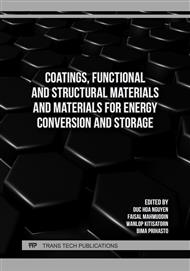p.45
p.53
p.61
p.79
p.93
p.105
p.113
p.119
p.137
Stress Corrosion Cracking of Brass in Chloride Solution
Abstract:
In this investigation, the resistance of brass material to stress corrosion cracking (SCC) in a chloride solution was assessed through adjustments in temperature (25°C, 35°C, and 45°C) and bending angles of the brass material (1.0 wt%, 2.0 wt%, and 3.5 wt%). The chosen solution closely resembles saltwater, making it suitable for testing, especially considering the widespread use of brass materials in various industrial sectors, particularly shipping. Stress corrosion cracking tends to impact brass materials under heavy loading. The primary objective of this study is to characterize the corrosion rate of brass materials. The method involved a bending test with angle variations of 180°, 90°, and 0°. Corrosion assessment utilized the Open Circuit Potential method, Anodic Polarization Tafel, and a digital microscope for the material's microstructure properties. According to the findings, brass material exhibits the lowest corrosion rate (10 x 10-6 mmpy) at a temperature of 25°C distilled water and an angle variation of 0°. Conversely, the corrosion rate increases with variations in bending angle, temperature, and the concentration of NaCl solution, as evidenced by the corrosion rate of 28.035 x 10-5 mmpy with an angle variation of 180°, to a corrosive solution of NaCl 3.5 wt% at a temperature of 45°C.
Info:
Periodical:
Pages:
93-104
Citation:
Online since:
December 2024
Price:
Сopyright:
© 2024 Trans Tech Publications Ltd. All Rights Reserved
Share:
Citation:



